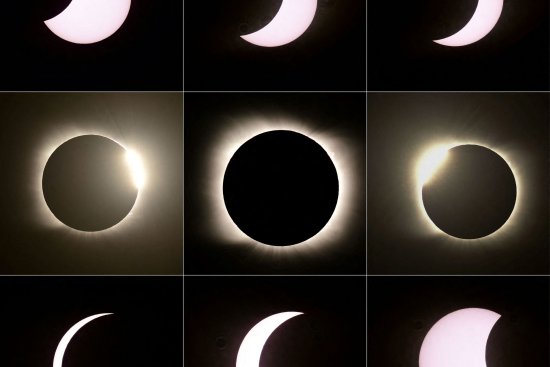
Today’s solar eclipse will plunge large swaths of the U.S. into near total darkness as 15 states witness the sun completely cover the moon.
It will enter the U.S. in Texas and exit in Maine, passing through Oklahoma, Arkansas, Missouri, Illinois, Kentucky, Indiana, Ohio, Pennsylvania, New York, Vermont, New Hampshire, and parts of Tennessee and Michigan. Millions of people are expected to watch the event, which is the last time a total solar eclipse will be visible in the contiguous United States until 2044.
[time-brightcove not-tgx=”true”]There are five major stages of the eclipse that stargazers should be on the lookout for. Here’s what to expect.
Stage 1: Partial eclipse begins
All 50 states in the U.S. will be able to witness a partial eclipse–but you must wear eclipse glasses to view it. During the partial eclipse, the moon’s shadow first becomes visible over the sun. The moment the moon’s shadow first touches the sun’s edge is known as “first contact.” In most locations, the partial eclipse lasts for 70-80 minutes.
Stage 2: “First contact” as the eclipse begins
The total eclipse begins when the sun is almost completely covered by the moon. Just before totality keep an eye out for Baily’s Beads, Shadow Bands, and the Diamond Ring.
Read More: How to Safely Watch the Total Eclipse
Baily’s Beads occur very briefly, as small beads of light become visible just as the eclipse enters totality. Shadow bands are faint, rapidly moving bands of light and dark that can be seen on the sides of buildings or the ground.
Just before totality, a single bright spot will remain, resembling a diamond in a ring. Be sure to keep your eclipse glasses on during this stage.
Read More: How to Use Your Smartphone to Take Photos of the Solar Eclipse
Stage 3: “Second contact” and totality
Eclipse viewers within the path of totality will witness the moon completely cover the sun, a phenomenon that typically lasts between 3.5 to 4 minutes. Totality, also known as “second contact” is the only phase of the eclipse in which it is safe to completely remove your eclipse glasses—just be sure to put them back on before totality ends.
Stage 4: “Third contact” and brightening
After totality, stargazers will see a partial eclipse again, also known as “third contact”. You will also have another opportunity to witness Baily’s Beads, Shadow Bands, and the Diamond Ring as the moon begins to inch away from the sun. Be sure to put your eclipse glasses back on before this stage begins.
Read More: What Happens If It’s Cloudy During an Eclipse?
Stage 5: “Fourth contact” as the eclipse ends
“Fourth contact” refers to the moment in which the sun is no longer covered by the moon. At this point, the eclipse is completely over, and you can safely remove your eclipse glasses.